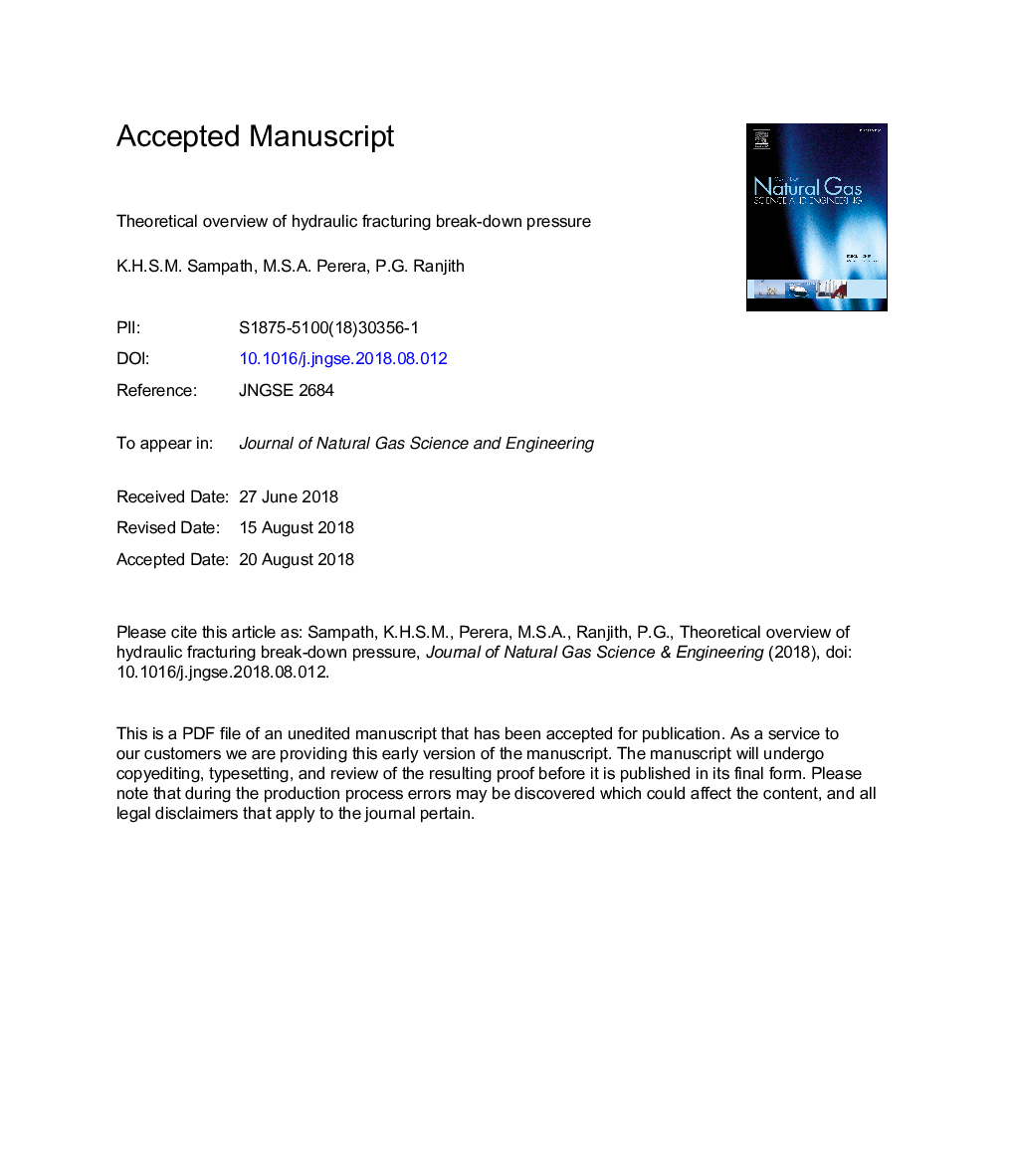| کد مقاله | کد نشریه | سال انتشار | مقاله انگلیسی | نسخه تمام متن |
|---|---|---|---|---|
| 9953706 | 1522985 | 2018 | 57 صفحه PDF | دانلود رایگان |
عنوان انگلیسی مقاله ISI
Theoretical overview of hydraulic fracturing break-down pressure
ترجمه فارسی عنوان
نظری نظری بر فشار شکستن هیدرولیکی شکستگی
دانلود مقاله + سفارش ترجمه
دانلود مقاله ISI انگلیسی
رایگان برای ایرانیان
کلمات کلیدی
شکستگی هیدرولیکی، فشار شکستن، مدل های نظری،
ترجمه چکیده
پیش بینی دقیق فشار شکسته ضروری است که برنامه پمپاژ و پارامترهای تحریک مربوط به یک فرایند شکستن هیدرولیکی تعریف شود. تعدادی از مدل های نظری براساس رویکردهای مختلف برای پیش بینی فشار شکسته در شرایط مختلف زمینه / مکان به دست آمده است. اگر چه مدلهای تحلیلی در طول زمان تکامل یافته اند، اختلاف نظر بین پیش بینی های نظری و نتایج آزمایشگاه / میدان وجود دارد. این مقاله به طور جامع از مشتقات، تحولات و محدودیت های بسیاری از مدل های شکست خورده موجود را بررسی می کند و پیشنهاداتی را برای بهبود بیشتر ارائه می دهد. در میان تعدادی از رویکردهای نظری، رویکرد مبتنی بر شدت تنش و روش مبتنی بر نرخ انتشار انرژی، پیش بینی های قابل اعتمادتری را ارائه می دهند که در بیشتر نتایج آزمایشگاهی و فیلد مطرح می باشد. رویکرد مبتنی بر استحکام کششی معمولا برای تولید مدل های شکست خورده استفاده می شود، اما اغلب کمی بیش از / تخمین های کمی فراهم می کند. رویکرد مبتنی بر برش یک روش بیش از حد ساده است و به ندرت برای پیش بینی های نظری استفاده می شود. این رویکردها شباهت زیادی دارند، بنابراین مدل های پیشرفته با ترکیب نظریه ها به منظور دقیق پیش بینی فشار شکسته توسعه داده شده است. عملیات شکستن هیدرولیک واقعی، یک فرآیند پیچیده است که شامل تعدادی از عوامل حاکم بر شامل مخزن و خواص مایع شکستگی می شود. تشخیص مدل نظری جهانی فراتر از حد امکان است، زیرا مدل سازی فشار برش برای یک مخزن داده شده نیاز به جزئیات خاصی از عملیات خاص و شرایط در محل دارد. با توجه به خواص مایع چند منظوره، تعاملات، رفتار جریان و تغییر فاز، فشرده سازی با غیر آب یا مخلوطی از مایعات شکستگی می تواند بسیار پیچیده باشد، بنابراین قبل از اجرای پروژه های بزرگ در مقیاس بزرگ، نیاز به تحلیلی، شبیه سازی های عددی و آزمایشات آزمایشگاهی / میدان وجود دارد.
موضوعات مرتبط
مهندسی و علوم پایه
علوم زمین و سیارات
علوم زمین و سیاره ای (عمومی)
چکیده انگلیسی
The precise prediction of the break-down pressure is imperative to define the pumping schedule and the relevant stimulation parameters of a hydraulic fracturing process. A number of theoretical models have been derived based on different approaches to predict the break-down pressure, under various field/in-situ conditions. Although, the analytical models have been evolved over time, disagreements exist between the theoretical predictions and the laboratory/field results. This paper comprehensively reviews the derivations, evolutions and limitations of most of the existing break-down models and provides suggestions for further improvements. Among a number of theoretical approaches, stress intensity factor-based approach and the energy release rate-based approach give more reliable predictions, which are in line with most of the laboratory and field results. The tensile strength-based approach is commonly used to derive break-down models, but often provides slightly over/under estimations. Shear-based approach is an oversimplified approach and rarely used for the theoretical predictions. The approaches share many similarities, thus advanced models have been developed by combining the theories to precisely predict the break-down pressure. The actual hydraulic fracturing operation is rather a complex process, which involves a number of governing factors including reservoir and fracking fluid properties. Derivation of a global theoretical model is beyond the bound of possibility, as the modelling of break-down pressure for a given reservoir requires specific details of the particular operation and the in-situ conditions. The fracking with non-aqueous or mixture of fracturing fluids can be much complex due to multifaceted fluid properties, interactions, flow behaviour and phase change, thus requires more analytical, numerical simulations and laboratory/field experiments prior to implementation of large scale field projects.
ناشر
Database: Elsevier - ScienceDirect (ساینس دایرکت)
Journal: Journal of Natural Gas Science and Engineering - Volume 58, October 2018, Pages 251-265
Journal: Journal of Natural Gas Science and Engineering - Volume 58, October 2018, Pages 251-265
نویسندگان
K.H.S.M. Sampath, M.S.A. Perera, P.G. Ranjith,
